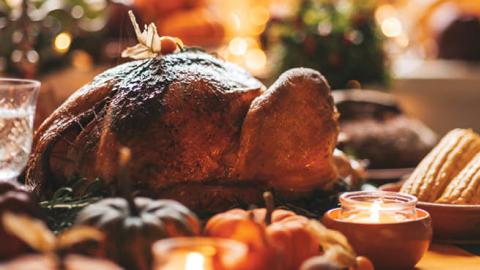Selected by Melanie Kirkpatrick, the author, most recently, of ‘Lady Editor: Sarah Josepha Hale and the Making of the Modern American Woman.’
Mourt’s Relation
By Edward Winslow (1622)
1. The year following the famous feast that has come to be known as the First Thanksgiving, a slim volume of Pilgrim writings titled “Mourt’s Relation” was published in London. Most of the entries recount—in fascinating detail—the Pilgrims’ interactions with the native people they encountered in the New World. The book’s most famous passage appears in a letter contributed by the Pilgrim leader Edward Winslow. Writing to an unnamed friend in England, Winslow describes an autumnal celebration in Plymouth enjoyed by the English settlers and members of the Wampanoag confederation of Indian tribes with whom they enjoyed friendly relations. The event took place at the conclusion of the harvest, Winslow tells us, “after we had gathered the fruit of our labors.” It lasted three days. Present were the “greatest king Massasoit, with some ninety men.” The Indians brought five deer to the feast, a contribution that would have amply fed the entire gathering for several meals. Winslow enthuses about the rich wildlife around Plymouth, including wild fowl that were so numerous that four Pilgrims were able to shoot enough in one day to serve everyone for almost a week. This upbeat picture of the First Thanksgiving may have been intended as a kind of recruitment tool, encouraging friends in England to join the settlers in Plymouth. “By the goodness of God,” Winslow concludes, “we are so far from want, that we often wish you partakers of our plenty.”
American Cookery
By Amelia Simmons (1796)
2. The first American cookbook doesn’t include the word “Thanksgiving.” But recipes for many of the classic Thanksgiving dishes appear in print for the first time here: roast turkey with bread stuffing, cranberry sauce, “minced” pie. There is even a recipe for chicken pot-pie, a must-serve feature of New England Thanksgiving dinners from the 18th century into the early 20th century. Despite their age, Simmons’s recipes will be familiar to modern-day Thanksgiving cooks. “Pompkin pudding” is the foremother of today’s pumpkin pie: a “paste,” or crust, filled with a mixture of stewed pumpkin, molasses, allspice and ginger. If your family seasons the stuffing for your Thanksgiving turkey with parsley, marjoram and sage, you will recognize Simmons’s take on it. American cooks have been boiling, stewing, roasting and grilling native foods ever since the arrival of the Mayflower, but Simmons’s cookbook was the first to publish recipes for Indian corn, Jerusalem artichokes, squash and other New World foods. With its emphasis on North American ingredients, “American Cookery” represented a culinary revolution. In the words of one admirer, it was “another declaration of American independence.”
Northwood
By Sarah Josepha Hale (1827)
3. The celebrated editor of Godey’s Lady’s Book, Sarah Josepha Hale, earned the nickname “godmother of Thanksgiving” in recognition of her long campaign for the establishment of a common day of Thanksgiving. Years before she initiated her campaign, however, Hale was proclaiming the virtues of Thanksgiving in her novel “Northwood.” Based on Hale’s childhood memories of New Hampshire in the late 18th century, “Northwood” contains the best description in American literature of Thanksgiving dinner. The “roasted turkey took precedence on this occasion . . . sending forth the rich odor of its savory stuffing.” Nearby were “innumerable bowls of gravy and plates of vegetables.” Dessert included “pies of every name and description ever known in Yankee land” with the pumpkin pie occupying “the most distinguished niche.” In a later edition, published in 1852, Hale added a passage making her case for Thanksgiving to become a national event. An American character tells a visitor from England: “Thanksgiving, like the Fourth of July, should be considered a national festival, and observed by all our people.” And so it is.
Of Plymouth Plantation, 1620-1647
By William Bradford (1856)
4. It is next to impossible to believe, but the Pilgrims didn’t become part of our Thanksgiving celebration until the middle of the 19th century, when William Bradford’s firsthand account of the event was discovered in the library of the bishop of London. Scholars believe that the 17th-century manuscript, in which the Plymouth governor recorded his history of the colony, was carried to England by a British looter during the Revolutionary War. Like Edward Winslow’s account, Bradford’s telling of the Thanksgiving story is brief and focuses on the New World’s natural bounty. “All the summer there was no want,” he writes. Come autumn, cod, bass and other fish were plentiful. Venison was easy to come by, and the Pilgrims took “a great store of wild turkeys.” A 21st-century reader may find it curious that Bradford didn’t call the harvest festival of 1621 a “thanksgiving.” Instead, he reserved his first use of that word for a religious event that took place in mid-July 1623, a day of thanksgiving in gratitude to God for a rainfall that ended a drought. Bradford’s manuscript became a literary sensation when it was published in 1856. It is an American classic that deserves to be better read today. Samuel Eliot Morison’s edition, published in 1952, is a marvel.
Two Thanksgiving Day Gentlemen
By O. Henry (1907)
5. Is there a sadder image in American culture than that of someone who has no invitation to Thanksgiving dinner? The great short-story writer O. Henry—pen name of William Sydney Porter—explores this idea and the theme of Thanksgiving generosity in his moving tale “Two Thanksgiving Day Gentlemen.” Stuffy Pete is down-and-out and living on the streets of New York City. Every Thanksgiving afternoon for the past nine years, an unnamed elderly gentleman has met him on a park bench in Union Square and treated him to a magnificent dinner at a nearby restaurant. This year, however, Stuffy Pete has already eaten dinner, courtesy of two rich old ladies who also have a Thanksgiving tradition of feeding the poor. When the old gentleman turns up as usual at his park bench, Stuffy Pete, seeing that the man’s eyes were “bright with the giving pleasure,” doesn’t have the heart to tell him he is not hungry. The duo go off to the restaurant, where the old gentleman watches happily as Stuffy Pete forces himself to eat another huge meal. After dinner, the men part. Now comes one of O. Henry’s distinctive twisty endings. The old gentleman collapses and is taken to the hospital, where it turns out he hasn’t eaten in three days. He had been saving his money so that he could give Stuffy Pete a grand Thanksgiving dinner.
Read in The Wall Street Journal















